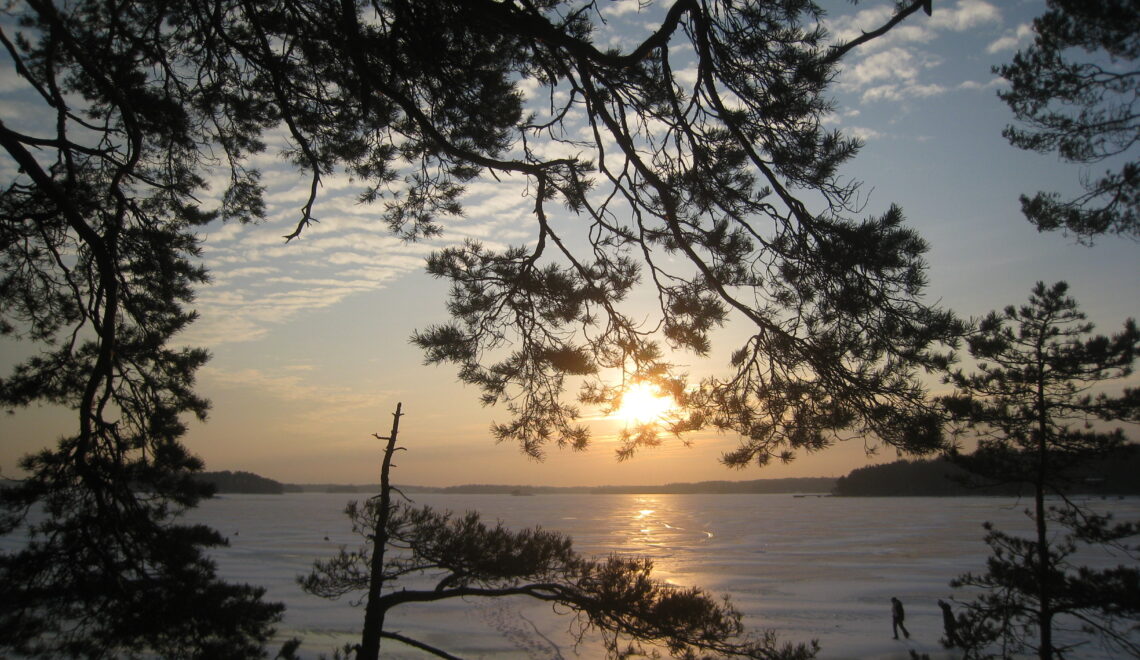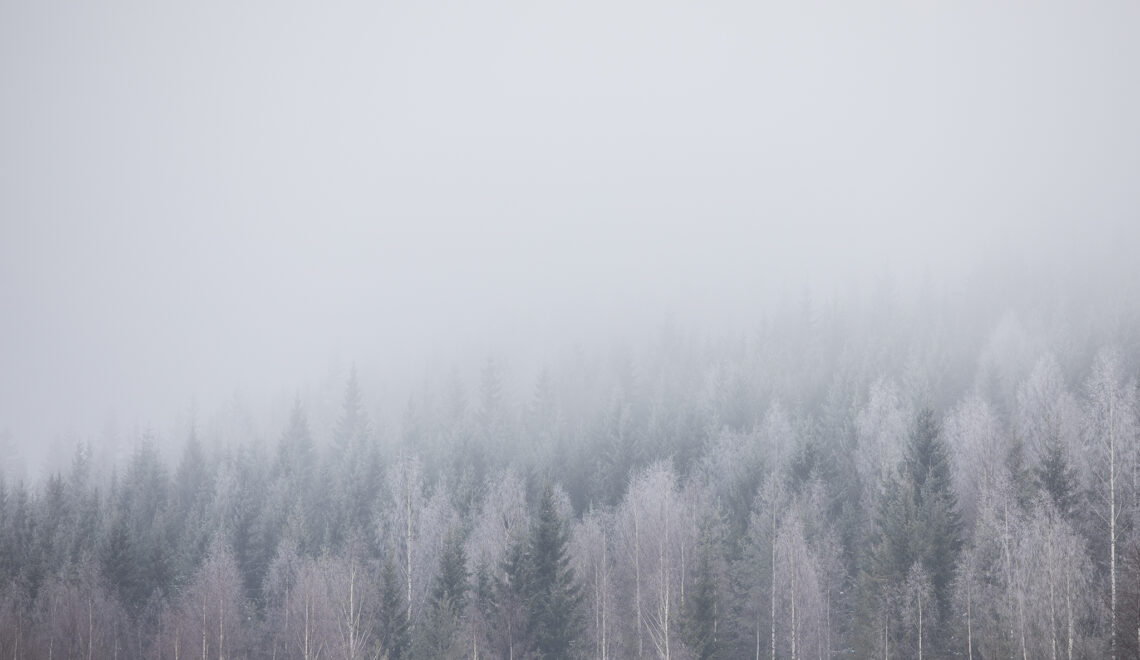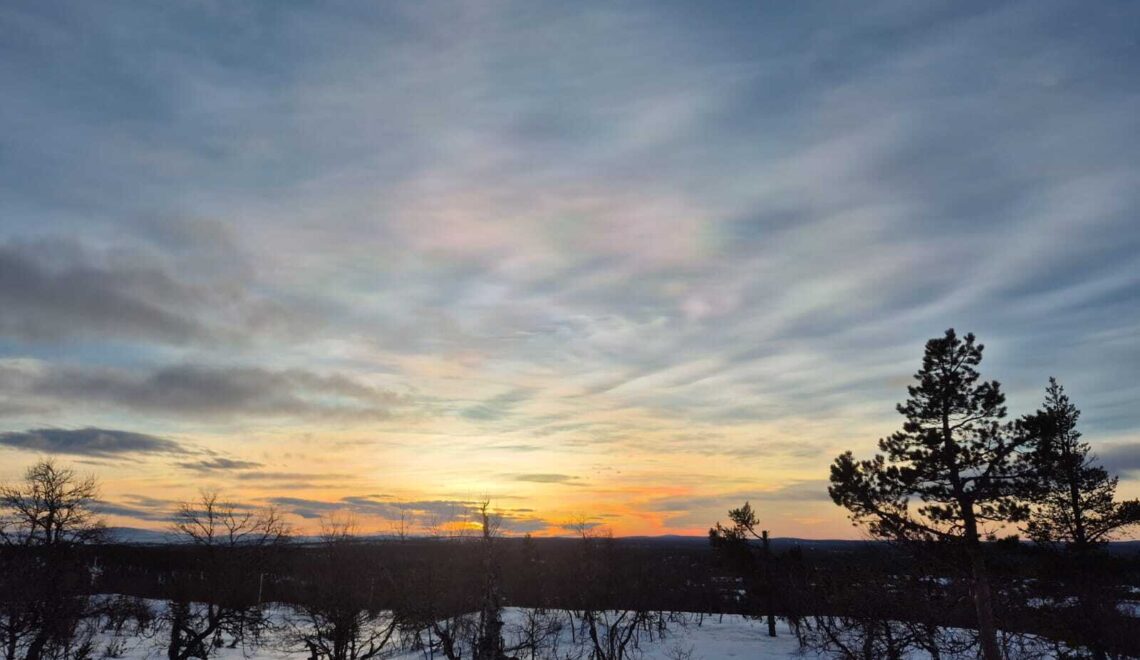Seasonal variation in natural light is an essential characteristic of the climate in high latitude areas, and global warming is expected to lead to significant changes in solar radiation as well. Insolation will decrease substantially over high-latitude sea areas. On wide land areas, solar radiation is projected to increase in summer and autumn. The contrast between insolation in winter and summer will increase especially under the high emission scenario. These future changes may pose substantial challenges for adaptation in ecosystems and societies.
REIJA RUUHELA, KIMMO RUOSTEENOJA, KAISA LAKKALA
Finnish Meteorological Institute
Solar radiation and the climate in high latitude areas. Seasonal variation in total incident solar radiation, and thus the availability of light, is a fundamental characteristic of the climate in high-latitude areas. Ecosystems and human beings have adapted to this seasonal cycle with long days in summer and polar nights in winter and are potentially vulnerable to changes induced by global warming. Up to date, rapid increases in temperature (Rantanen et al., 2022) and precipitation have received a lot of attention, but in addition, changes in solar radiation are essential for climate change adaptation studies. Here, we focus on describing those changes from a polar perspective of the Northern Hemisphere, north of the latitude 45°N. Changes in cloudiness, atmospheric water vapour content or aerosol load may lead to responses in incident solar radiation at the surface (Ruosteenoja et al., 2019). Surface properties such as snow or ice cover likewise impact insolation via reflections between the surface and cloud base. Previously, Ruosteenoja and Jylhä (2021) derived projections of multiple climate variables for Finland from CMIP6 global climate models. That study indicated that solar radiation is likely to decrease in winter months and slightly increase in summer in Finland. These projected changes are consistent with the projected changes in precipitation patterns.
Polar perspective for the changes in solar radiation. In this study, we used simulations from 28 global climate models participating in Phase 6 of the Coupled Model Intercomparison Project (CMIP6). First, multi-model means of projected monthly mean changes in the incident solar radiation were calculated for the time period of 2070–2099. Secondly, the averages were divided by the mean value of the 28 models for the baseline period 1981–2010 to convert the changes into percentages. Three different greenhouse gas scenarios were explored. The high-emission SSP5–8.5 scenario is estimated to lead to a global warming of 4.4°C (uncertainty range 3.3–5.7°C), relative to pre-industrial conditions, by the end of the 21st century (IPCC, 2021, Table SPM.1). The corresponding global warming for the medium-level SSP2-4.5 scenario is 2.7°C (2.1–3.5°C) and for the very low-emission SSP1-2.6 scenario 1.8°C (1.3–2.4°C). It should be noted that the high-emission SSP5-8.5 scenario is in sharp contradiction with the goals of current climate policy, while SSP1-2.6 would require very drastic and urgent reductions in greenhouse-gas emissions. Accordingly, the emphasis is here given to SSP2-4.5. More detailed technical information and the list of models utilized are given in Section 2 and Table 1 of Ruosteenoja and Jylhä (2021).
Decrease in solar radiation in the Arctic. Figures 1 and 2 show projected monthly-mean changes in the incident solar radiation from the period 1981–2010 to 2070–2099 for the entire high-latitude area and discrete positions. Large decreases in insolation are seen in those sea areas from where the ice cover retreats in the future, such as the Barents Sea, Hudson Bay and Okhotsk Sea in winter and spring, and the central Arctic Sea in summer and early autumn. On land areas, substantial decreases in insolation are projected for northern Eurasia and Canada, particularly in autumn. Conversely, on wide land areas both in Eurasia and North America, increases are projected for summer and early autumn. In particular, in central Europe, increases in solar radiation occur throughout the year. Figure 2 demonstrates how seasonal variation in solar radiation will change in selected high-latitude regions. Especially under the high-emission scenario, the contrast between winter and summer insolation will increase since the solar radiation decreases in winter and slightly increases in summer from the baseline values, apart from the very high-latitude area. However, at all the example points, there are substantial inter-model differences in the projected changes.
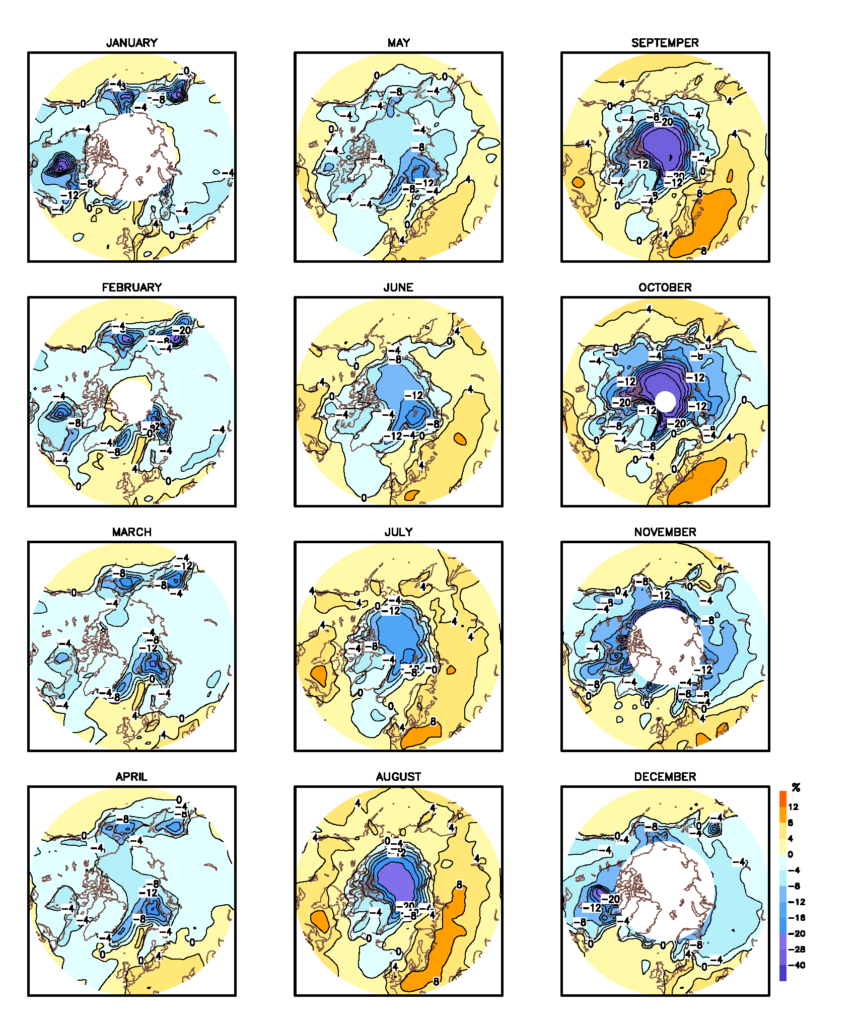
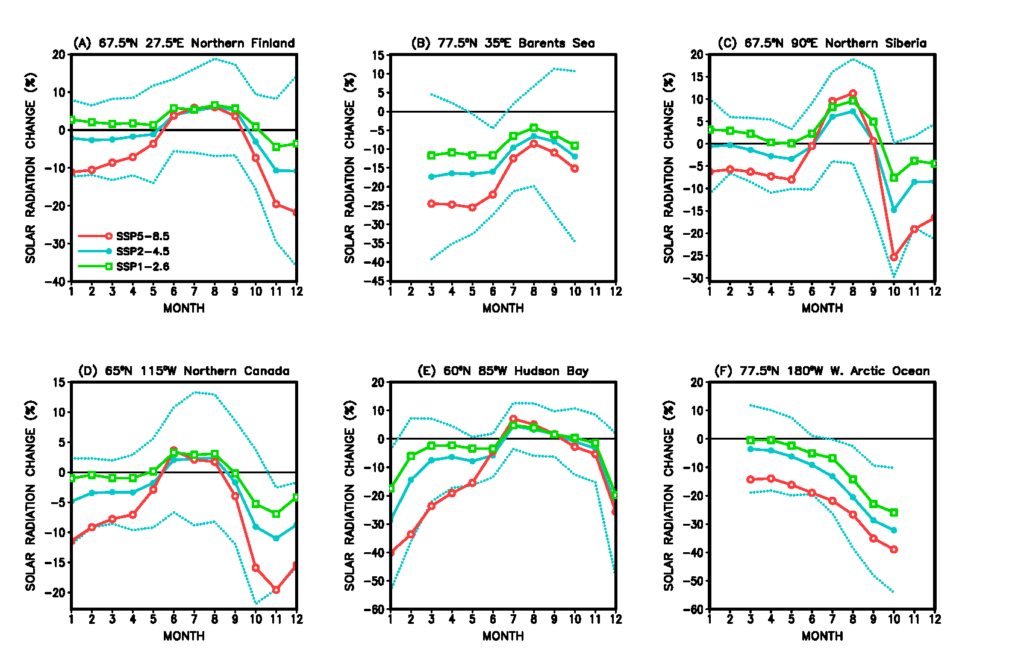
Potential factors behind the projected changes. There are several factors that can explain the above-described changes in the incident solar radiation. Since it was beyond the scope of this study to make data analyses for all the related climate variables, these are discussed here in a qualitative sense only. Owing to increasing temperatures, the water vapour content of the atmosphere will increase everywhere, which acts to decrease incoming near-infrared solar radiation. The emissions of the precursors of aerosols are anticipated to decrease in the middle latitudes, most strongly under the SSP1-2.6 scenario (IPCC, 2021, Fig. SPM.4). Owing to long-range transport, this tends to reduce the aerosol load even over the Arctic Ocean, where local anthropogenic sources are negligible. However, the emission of natural aerosols, such as sea spray, may also change due to decreasing sea ice. Cloudiness is projected to increase in the Arctic area but decrease in the middle latitudes, especially in central Europe (IPCC, 2013, Fig. 12.17). This is in agreement with the central European summers becoming dryer in the future, with decreasing precipitation and relative air humidity (Ruosteenoja and Jylhä, 2021, Figs. 11 and S7). In the high latitudes in particular, retreating ice and snow cover act to reduce the surface albedo and consequently the backscatter of shortwave radiation between the surface and cloud base. Evidently, this is an important factor explaining the seasonal course of the radiation response, e.g., the largest reductions taking place in winter in Hudson Bay but in late summer in the central Arctic Ocean (Figs. 1–2).
In this study we focused on the projected changes in incident solar radiation. However, for global climate change the total radiation balance, thus, also changes in outgoing longwave radiation are essential. In addition to greenhouse gas concentrations, local longwave radiation balance is affected by cloudiness and water vapour content.
Challenges for climate change adaptation. Disappearance of snow and ice cover reduces the surface shortwave albedo considerably. Therefore, even though incident solar radiation in the Arctic Ocean is projected to decrease, it is evident that heat absorbed in the ocean during the prolonged ice-free season increases. The extra heat stored in the water mass acts to delay the autumnal freeze-up and thus substantially increases temperatures in autumn and winter (Stroeve et al, 2014).
Projected changes in solar radiation in high latitudes may have impacts on many sectors of society, and the findings of this study can be used, e.g., in assessing future climate change induced risks. We did not study changes in the spectrum of solar radiation, but changes in the short-wavelength part, ultraviolet (UV) radiation, reaching the surface may have a significant effect on living organisms, as the UV radiation is well-known for its biological effectiveness in both aquatic and terrestrial ecosystems (EEAP, 2023). Ultraviolet radiation is highly correlated with changes in total incident solar radiation, especially if changes are due to cloudiness, aerosols or surface reflection. In addition, changes in the short-wavelength portion of UV radiation depends on changes in atmospheric ozone.
Changes in solar radiation have direct impacts on human health. Decreasing solar radiation together with shortening snow and ice cover period in winter may lead to more severe symptoms related to seasonal affective disorders (Burenby et al., 2021). In areas of increasing solar radiation where no significant ozone increase is projected, the risks related to excessive UV exposure may increase, in particular, if people spend more time outdoors than nowadays. Changes in radiation also contribute to the thermal sensation that people experience. The climate change induced temperature increase might change dressing habits towards less protective clothes, e.g., longer time periods spent in shorts and T-shirts. The risk of getting skin cancer can then increase. Eye diseases like cataract may also become more common in prolonged UV exposure without adequate UV protection (Lucas et al., 2019).
Arctic ecosystems are very sensitive to changes in climate variables and their compound effects. For instance, rapidly increasing temperatures and decreasing snow and ice cover may lead to unprecedented exposure of aquatic ecosystems to solar radiation incl. UV-radiation, also in seasons that in past climates used to be well protected from radiation under the sea ice. That may affect, for example, small aquatic organisms that lack a shell structure as well as fish eggs which are especially vulnerable to UV radiation. UV radiation also acts as a driver for chemical reactions in the atmosphere which affect air quality, e.g., altering the production and decomposition of O3 at ground level. In addition, UV radiation is known to degrade materials, which can be observed as fading, yellowing, and embrittlement (UNEP, 2023).
We conclude that future changes in incident solar radiation in high latitude areas are substantial and should be taken into account more comprehensively in climate change impact studies and in the adaptation plans in these regions.
Acknowledgements: We thank the Research Council of Finland for funding this work via the CHAMPS project (project no 329225).
References
Burenby, L., and Coauthors, 2021: Climate change and mental health. Finnish Institute for Health and Welfare (THL). Discussion paper 32/2021. Helsinki, Finland 2021. ISBN 978-952-343-765-4.
EEAP (Environmental Effects Assessment Panel), 2023: Environmental Effects of Stratospheric Ozone Depletion, UV Radiation, and Interactions with Climate Change, 2022 Assessment Report. Nairobi: Environmental Effects Assessment Panel, United Nations Environment Programme. https://ozone.unep.org/system/files/documents/EEAP-2022-Assessment-Report-May2023.pdf.
IPCC, 2013. Climate Change 2013: The physical science basis. Contribution of Working Group I to the Fifth Assessment Report of the Intergovernmental Panel on Climate Change. Cambridge University Press, Cambridge, U.K., 1535 pp. [Stocker, T.F., and Coauthors (eds.)].
IPCC, 2021. Climate Change 2021: The Physical Science Basis. Contribution of Working Group I to the Sixth Assessment Report of the Intergovernmental Panel on Climate Change. [Masson-Delmotte, V., and Coauthors (eds.)] Cambridge University Press.
Lucas R. M., and Coauthors, 2019: Human health in relation to exposure to solar ultraviolet radiation under changing stratospheric ozone and climate. Photochem Photobiol Sci., 18(3), 641–680, https://doi.org/10.1039/c8pp90060d.
Rantanen, M., and Coauthors, 2022: The Arctic has warmed nearly four times faster than the globe since 1979. Commun Earth Environ 3, 168, https://doi.org/10.1038/s43247-022-00498-3
Ruosteenoja, K., and Coauthors, 2019: Future Changes in Incident Surface Solar Radiation and Contributing Factors in India in CMIP5 Climate Model Simulations. J. Appl. Meteor. Climatol., 58, 19–35, https://doi.org/10.1175/JAMC-D-18-0013.1.
Ruosteenoja, K., and K. Jylhä, 2021: Projected climate change in Finland during the 21st century calculated from CMIP6 model simulations. Geophysica, 56(1), 39–69, https://www.geophysica.fi/pdf/geophysica_2021_56_1_039_ruosteenoja.pdf.
Stroeve, J. C., and Coauthors, 2014: Changes in Arctic melt season and implications for sea ice loss. Geophys. Res. Lett., 41(4), 1216–1225, https://doi.org/10.1002/2013GL058951.
UNEP (United Nations Environment Programme), 2023: Questions and Answers about the Effects of Ozone Depletion, UV Radiation, and Climate on Humans and the Environment. Supplement of the 2022 Assessment Report of the UNEP Environmental Effects Assessment Panel, 25 pp.; UNEP: Nairobi, 2023. https://ozone.unep.org/system/files/documents/EEAP-assessment-report-2022-QA.pdf.
HOW TO CITE THIS ARTICLE:
Ruuhela R., K. Ruosteenoja, K. Lakkala, 2023: Projected changes in incident solar radiation in Northern Hemisphere high-latitude areas, FMI’s Clim. Bull. Res. Lett., [preprint], https://doi.org/10.35614/ISSN-2341-6408-IK-2024-02-RL
CITATION INFORMATION:
Authors: Reija Ruuhela, Kimmo Ruosteenoja, Kaisa Lakkala
Received: September 7, 2023
Accepted: December 1, 2023
First online: December 7, 2023
Published: coming, Spring 2024
Journal: FMI’s Climate Bulletin Research Letters
Volume: 6
Issue: 1
Pages: X-X
DOI: https://doi.org/10.35614/ISSN-2341-6408-IK-2024-02-RL
Header image: Adobe Stock

